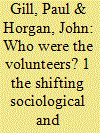|
|
|
Sort Order |
|
|
|
Items / Page
|
|
|
|
|
|
|
| Srl | Item |
| 1 |
ID:
148908


|
|
|
|
|
| Summary/Abstract |
In this supreme hour the Irish nation must, by its valour and discipline and by the readiness of its children to sacrifice themselves for the common good, prove itself worthy of the august destiny to which it is called.
|
|
|
|
|
|
|
|
|
|
|
|
|
|
|
|
| 2 |
ID:
188089


|
|
|
|
|
| Summary/Abstract |
This study analyzes the effects of conspiracy beliefs on violent extremist intentions. More specifically, we investigate whether the relationship between conspiracy beliefs and violent extremism depends upon individual characteristics such as varying levels of self-efficacy, self-control, and law-relevant morality. Variable interactions examine where conspiracy beliefs exert strong effects on violent extremist intentions. The analysis is based on a German nationally representative survey (N = 1502). To our knowledge, it is the first and only nationally representative survey carried out in violent extremism research.
|
|
|
|
|
|
|
|
|
|
|
|
|
|
|
|
| 3 |
ID:
148912


|
|
|
|
|
| Summary/Abstract |
Counterterrorism strategies involving the killing of terrorists are a prominently used but controversial practice. Proponents argue that such strategies are useful tools for reducing terrorist activity, while critics question their effectiveness. This article provides empirical insight into this strategy by conducting a series of negative binomial regression and Tobit estimations of the impact of killing Provisional Irish Republican Army (PIRA) terrorists as well as members of the Catholic community on counts of PIRA bombings and targeting activity in Northern Ireland for the period 1970–1998. We consider the impact of discriminate and indiscriminate killings (where only PIRA militants are killed versus those in which both militants and civilians are also killed) on subsequent PIRA improvised explosive device (IED) attacks. Our findings illustrate that while total and discriminate counterterrorism killings have little to no effect on PIRA IED attacks, indiscriminate counterterrorism killings increased PIRA bombings overall and prompted the Provisional IRA to specifically target civilians in IED events. We conclude by discussing the scholarly and policy implications of these findings.
|
|
|
|
|
|
|
|
|
|
|
|
|
|
|
|
| 4 |
ID:
138074


|
|
|
|
|
| Summary/Abstract |
This paper presents an analysis of the Provisional Irish Republican Army’s (PIRA) brigade level behavior during the Northern Ireland Conflict (1970-1998) and identifies the organizational factors that impact a brigade’s lethality as measured via terrorist attacks. Key independent variables include levels of technical expertise, cadre age, counter-terrorism policies experienced, brigade size, and IED components and delivery methods. We find that technical expertise within a brigade allows for careful IED usage, which significantly minimizes civilian casualties (a specific strategic goal of PIRA) while increasing the ability to kill more high value targets with IEDs. Lethal counter-terrorism events also significantly affect a brigade’s likelihood of killing both civilians and high-value targets but in different ways. Killing PIRA members significantly decreases IED fatalities but also significantly decreases the possibility of zero civilian IED-related deaths in a given year. Killing innocent Catholics in a Brigade’s county significantly increases total and civilian IED fatalities. Together the results suggest the necessity to analyze dynamic situational variables that impact terrorist group behavior at the sub-unit level.
|
|
|
|
|
|
|
|
|
|
|
|
|
|
|
|
| 5 |
ID:
175731


|
|
|
|
|
| Summary/Abstract |
Although there has recently been a considerable increase in research into lone actor terrorism, one of the main areas that remains understudied is that of target selection. The lack of empirically driven studies that can guide prevention measures is a notable oversight. This paper applies methods from environmental criminology to examine the residence-to-attack journeys of 122 lone terrorist acts in the U.S and Europe. The distance decay effect was evident, and significant differences were found between subgroups. Individuals were more likely to travel further if a) they were in the U.S, b) they had links to a wider network, c) they had a single-issue ideology, d) they attacked an iconic target, e) they attacked a symbolic building, or f) they used a bomb as their main weapon. A few case studies are discussed which highlight a need to conduct further research that considers the whole nodal network of an individual. The findings suggest that distance can be put forward as a constraining factor on lone actor target selection and provide support for the notion that the spatial decision making of terrorists is similar to traditional criminals.
|
|
|
|
|
|
|
|
|
|
|
|
|
|
|
|
| 6 |
ID:
144888


|
|
|
|
|
| Summary/Abstract |
Recent research on lone-actor terrorism has found a high prevalence of mental health disorders among these offenders. This research note addresses two shortcomings in these existing studies. First, it investigates whether selection effects are present in the selection process of terrorist recruits. Second, it builds on the argument that mental health problems and terrorist behavior should not be treated as a yes/no dichotomy. Descriptive results of mental health disorders are outlined utilizing a number of unique datasets.
|
|
|
|
|
|
|
|
|
|
|
|
|
|
|
|
| 7 |
ID:
169917


|
|
|
|
|
| Summary/Abstract |
This paper applies the distance-to-crime approach to the case of Improvised Explosive Device (IED) and shooting attacks conducted by the Provisional Irish Republican Army (PIRA) during the Northern Ireland conflict, 1970–1998. The aim is to (a) measure the typical ‘distance to crime’ (b) detect whether a distance-decay effect is noticeable and (c) investigate whether there is a discernible difference in the distance traveled depending upon individual offender characteristics or aspects of how the offence was committed. In particular, it highlights that many of the same dynamics that influence offender decision making within the volume crime world, also apply within the terrorism realm. Five findings stand out in particular. First, a distance decay effect is identifiable. Second, younger offenders travel significantly smaller distances. Third, complex attacks typically involve greater distances. Fourth, our results show the ability of leading decision-makers within PIRA to impact upon the day-to-day operations of the field operatives. Together the results reinforce the argument that when we focus on terrorism from a preventative angle, we should focus on their behaviors: what they do rather than remain preoccupied with concerns about who they are and/or what they might be like. Collectively the results also highlight the fact that for a finer-grained understanding of terrorist behavior we need to disaggregate on a number of levels: within the cadre of operatives, across terrorist attacks, across targets and within conflicts.
|
|
|
|
|
|
|
|
|
|
|
|
|
|
|
|
| 8 |
ID:
188374


|
|
|
|
|
| Summary/Abstract |
Guided by previous research and recent empirical analyses, this paper gives insight into elements that characterize the spatial decision making of terrorist target selection. Five key factors explain why targets are chosen by terrorists. The authors propose that, generally, targets will be selected when they are Tolerable, Relevant, Accessible, Close and/or Known. This is followed by a discussion of attacks witnessed between January 2013 and December 2018 in the United Kingdom, and implications.
|
|
|
|
|
|
|
|
|
|
|
|
|
|
|
|
| 9 |
ID:
154971


|
|
|
|
|
| Summary/Abstract |
This article provides an overview of Provisional Irish Republican Army (PIRA) innovations with regards to improvised explosive devices (IEDs). It situates PIRA's tactical innovations within the broad organizational psychology literature focused on the nature and drivers of creativity and innovation. This discussion helps frame the two empirical analyses that follow. The first analysis provides a graphical timeline of PIRA's radical innovations (and their drivers) in relation to IED technology. This helps provide a sense of the specific occasions in which PIRA innovations were numerous and when they were sparse. The second analysis looks at the locations in which PIRA radical innovations debuted. This provides us with an understanding of the specific PIRA units responsible for these innovations. The results demonstrate that while PIRA operations spanned the six counties of Northern Ireland for 29 years, radical IED innovations were conceived, developed, and initially implemented within only two areas of operations for only seven of those years.
|
|
|
|
|
|
|
|
|
|
|
|
|
|
|
|
| 10 |
ID:
172497


|
|
|
|
|
| Summary/Abstract |
Terrorists from a wide array of ideological influences and organizational structures consider security and risk on a continuous and rational basis. The rationality of terrorism has been long noted of course but studies tended to focus on organizational reasoning behind the strategic turn toward violence. A more recent shift within the literature has examined rational behaviors that underpin the actual tactical commission of a terrorist offense. This article is interested in answering the following questions: What does the cost–benefit decision look like on a single operation? What does the planning process look like? How do terrorists choose between discrete targets? What emotions are felt during the planning and operational phases? What environmental cues are utilized in the decision-making process? Fortunately, much insight is available from the wider criminological literature where studies often provide offender-oriented accounts of the crime commission process. We hypothesize similar factors take place in terrorist decision making and search for evidence within a body of terrorist autobiographies.
|
|
|
|
|
|
|
|
|
|
|
|
|
|
|
|
| 11 |
ID:
188025


|
|
|
|
|
| Summary/Abstract |
This article contributes to the growing body of knowledge on lone-actor terrorism with the incorporation of closed-source data. The analyses presented investigate the antecedent behaviors of U.K.-based lone-actor terrorists leading up to their planning or conducting a terrorist event. The results suggest that prior to their attack or arrest the vast majority of lone-actor terrorists each demonstrated elements concerning (a) their grievance, (b) an escalation in their intent to act, (c) gaining capability—both psychologically and technically and (d) attack planning. The results also disaggregate our understanding of lone-actor terrorists in two ways. First, we compare the behaviors of the jihadist actors to those of the extreme-right. Second, we visualize Borum’s (2012) continuums of loneness, direction, and motivation. Collectively the results provide insight into the threat assessment and management of potential lone actors.
|
|
|
|
|
|
|
|
|
|
|
|
|
|
|
|
| 12 |
ID:
121903


|
|
|
|
|
| Publication |
2013.
|
| Summary/Abstract |
This article presents an empirical analysis of a unique dataset of 1240 former members of the Provisional Irish Republican Army (PIRA). We highlight the shifting sociological and operational profile of PIRA's cadre, and highlight these dynamics in conjunction with primary PIRA documents and secondary interview sources. The effect of these changes in terms of the scale and intensity of PIRA violence is also considered. Although this is primarily a study of a disbanded violent organization, it contains broad policy implications beyond the contemporary violence of dissident movements in both Northern Ireland and the Republic of Ireland. We conclude with a consideration of how a shifting sociological profile impacts upon group effectiveness, resilience, homogeneity, and the turn toward peaceful means of contention.
|
|
|
|
|
|
|
|
|
|
|
|
|
|
|
|
|
|
|
|
|